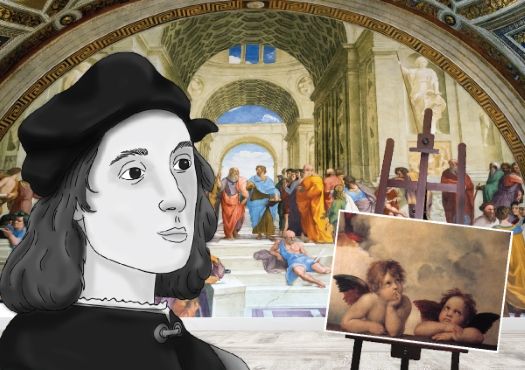As Vasari stated, “possessors of such rare and numerous gifts as were seen in Rafaello da Urbino, are not merely men, but mortal gods.”

This fresco, depicting a gathering of classical Greek philosophers, noted contemporary scholars, and artists, uses perspective to draw the viewer’s gaze toward the central figures of Plato on the left and Aristotle on the right, walking as they discuss philosophical matters under the replicating arches. The scene is animated, as groups in discussion cluster on both the left and right, creating a contrast with other individual figures that sit in solitary reflection. For example, the figure of Heraclitus (thought to be a portrait of Michelangelo) sits in the lower center, his head resting on his hand, as he seems to be sketching, while on the right of the stairs the cynic philosopher Diogenes sprawls. A statue of Apollo, god of music and art, stands on the left, while a statue of Athena, goddess of reason and wisdom stands on the right, symbolizing the division between Plato’s philosophy of ideal forms and Aristotle’s emphasis on logic and empirical knowledge.
By combining figures from the contemporary world with revered ancient Greeks, the work becomes a visual embodiment of the thriving Renaissance adoption of humanism. Raphael innovatively uses color to create a sense of dynamic intellectual movement, as notes of blue on the right and red on the left draw the eye along the diagonals created by the perspective toward Plato and Aristotle.
The architectural setting of the fresco seamlessly merges with the piece as a perfect example of trompe l’oeil. It is as if the wall itself is opening to reveal this spacious classical setting, its arches leading to the blue sky in the background. The building depicted is a Greek cross, and was influenced by the architect Bramante’s designs. Later working as an architect, Raphael wrote that he hoped ” to renew the beautiful forms of ancient buildings.” As Jonathan Jones, the art critic noted, Raphael was prolific, in that he “does this not just in his architecture – little of which was ever completed – but in his paintings.”
Fresco – Vatican City
Source: https://www.theartstory.org




